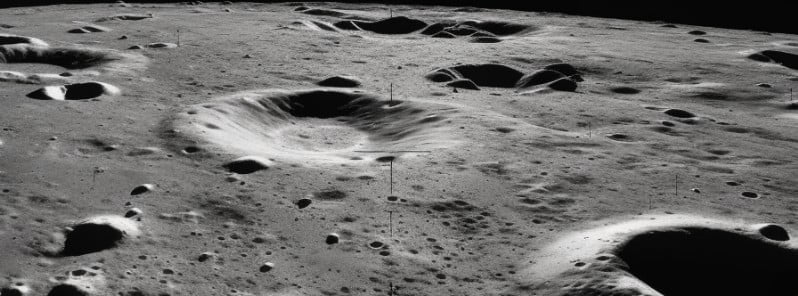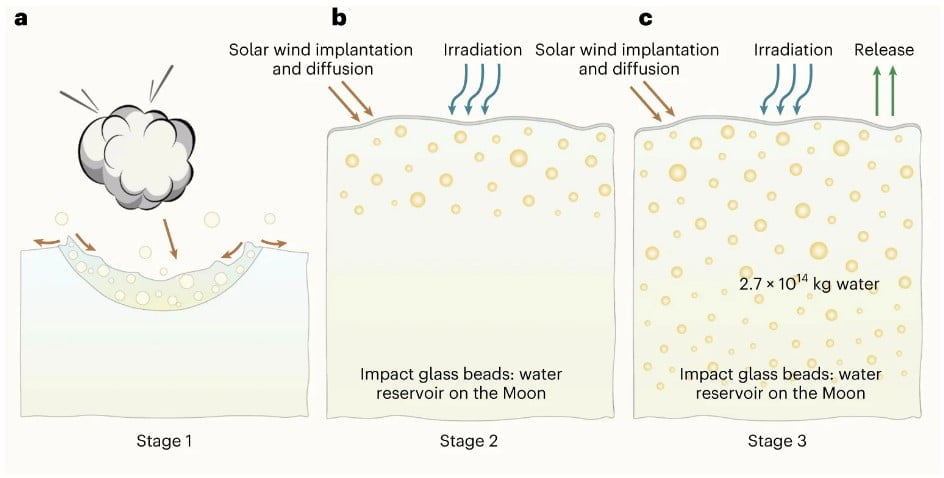Study sheds light on the origin of lunar surface water

A new study in Nature Geoscience identified impact glass beads in lunar soils as a significant water reservoir. The researchers estimate that the total amount of water contained within impact glass beads found in lunar soils could be as much as 2.7 x 1014 kg — equivalent to 270 trillion kg.
The study analyzed impact glass beads from lunar soils returned by the Chang’e-5 mission and found them to be a significant water reservoir on the Moon’s surface, providing crucial insights into the origin, spatial distribution, and evolution of lunar surface water.
The past two decades have seen substantial evidence supporting the presence of water on the Moon, with water ice detected at the lunar poles, hydroxyl and water absorption bands identified all over the Moon’s surface, and high water-ice abundances found in permanently shadowed regions. However, the origin of this lunar surface water and its distribution and evolution during regolith gardening remained largely unknown.
There are several potential sources and processes contributing to the water inventory at the surface of the Moon, such as solar wind implantation, lunar volcanism, deposition of volatile-bearing pyroclastic deposits and minerals, and impacts of comets and asteroids. Solar wind hydrogen-ion implantation is generally considered to react with surface minerals to produce hydroxyl or water in lunar soils. A lunar water cycle was proposed to describe the retention, release, and replenishment of water on the surface of the Moon.

The study examined the petrography, major element composition, Raman characteristics, water abundance, and hydrogen isotope composition of impact glass beads from the Chang’e-5 mission. A recent geochronological study showed that these glass beads formed more or less continuously for the past 2 billion years, with prominent peaks in formation ages at approximately 575 million years ago, 380 million years ago, 68 million years ago, and 35 million years ago.
By identifying impact glass beads in lunar soils as a significant water reservoir, this study has unveiled crucial information about the Moon’s surface water cycle. This finding could potentially influence future lunar surface exploration and help better understand the (sub)surface water reservoir and processing on other airless bodies in our Solar System.
While the water found in the impact glass beads on the Moon’s surface is potentially usable, it would require extraction and processing before it could be used. The water exists in the form of hydroxyl (OH) or water (H2O) molecules within the glass beads. To utilize this water, it would need to be extracted from the glass beads and purified to meet the requirements for human consumption, hygiene, or other purposes like producing oxygen and rocket fuel. Further research and development of technologies for efficient extraction and processing of this water source would be necessary to make it usable for human exploration and potential moon bases.
References:
1 A solar wind-derived water reservoir on the Moon hosted by impact glass beads – He, H., Ji, J., Zhang, Y. et al. – Nature Geoscience – March 27, 2023 – https://doi.org/10.1038/s41561-023-01159-6 – OPEN ACCESS
Featured image credit: The Watchers (stock)

Commenting rules and guidelines
We value the thoughts and opinions of our readers and welcome healthy discussions on our website. In order to maintain a respectful and positive community, we ask that all commenters follow these rules:
We reserve the right to remove any comments that violate these rules. By commenting on our website, you agree to abide by these guidelines. Thank you for helping to create a positive and welcoming environment for all.